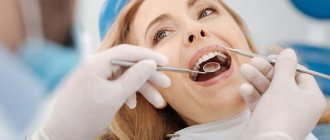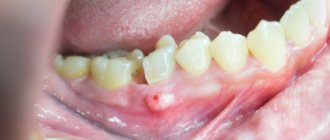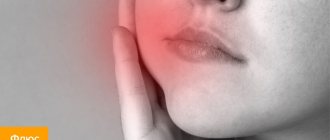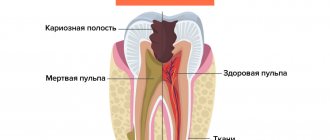What it is
One of the most common dental injuries, mostly occurring in childhood, is bruising. Of course, this kind of damage cannot be ruled out in adults, especially those leading an active lifestyle and involved in traumatic sports.
A tooth bruise is a closed injury caused by strong mechanical impact with a hard object. In this case, the integrity of the bone tissue and the anatomical position are not damaged, but the periodontal tissues suffer, sometimes severe rupture occurs, followed by bleeding.
If the blow was so powerful that the neurovascular bundle was damaged, the tooth may become stained or darkened due to hemorrhage into the dentinal tubules and pulp tissue. Occasionally, with a bruise, numbness is one of the accompanying signs, as well as external damage to the facial area in the injured area, as well as the appearance of swelling and bruising. In any case, most often all these damages are reversible and can be treated if you consult a dentist in a timely manner.
What causes bruises?
Jaw injury may result from:
- falls;
- blow;
- fights;
- children's games;
- accidents, etc.
The severity of the injury is determined taking into account the following factors:
- features of the surface or object that caused the injury;
- impact intensity;
- affected area of the face;
- condition of bone tissue before the incident.
The strength of the bruise and possible complications depend on the listed indicators. Regardless of the severity, it is important to see a doctor to evaluate the condition and prescribe appropriate treatment. This will avoid unforeseen consequences and quickly restore the damaged area.
Causes
Like any other injury, a tooth bruise can have a wide variety of causes. This could be an accidental hit in the jaw with a ball or other sports equipment, an unfortunate fall, a strong blow in a fight, or the consequence of a road accident or riding a bicycle. All these reasons have one thing in common - a strong blow of a mechanical nature.
Children and athletes are the most vulnerable to such injuries. It is these two categories of patients with a similar diagnosis that are the most frequent visitors to dental clinics. However, household injuries, as a result of which a person accidentally or recklessly hits a tooth, can cause a bruise. In this case, the most unprotected and weakest anterior and lateral incisors on the upper jaw most often suffer due to the anatomical structure and overhang of the upper jaw over the lower jaw.
Classification of dental injuries
The causative factors of dental trauma can be chronic or acute depending on the duration of exposure. The time of occurrence of injuries to permanent and temporary teeth differs.
All injuries are divided into eight classes, namely:
- Bruises of teeth, characterized by cracks in the enamel.
- Fractures of the coronal part of the tooth (uncomplicated).
- Fractures of the coronal part of the tooth (complicated).
- Complete fractures of the tooth crown.
- Longitudinal crown-root fractures.
- Fractures of dental roots.
- Incomplete dislocations/subluxations of teeth.
- Complete dislocation of teeth.
There are combined types of injuries that combine two or more forms.
Symptoms
The symptoms accompanying a tooth bruise are easy to recognize. If a person bruises a tooth, it hurts quite noticeably, and over time the pain only intensifies, especially with pressure on the damaged area and chewing food. The following symptoms are also present:
- When the neurovascular connection is ruptured, hemorrhage occurs into the pulp tissue, due to which the enamel quickly turns pink;
- The crown may darken;
- When bruised, the tooth becomes loose, although its mobility is relatively small;
- At the site of impact on the soft tissues of the gums, swelling, hyperemia, deformation of individual areas of the mucous membrane, and the formation of hematomas may occur;
- If there is a very strong impact, ligament rupture, joint damage, or even a fracture of the alveolar process of the jaw may occur where the striking object hits the jaw. In this case, it will be difficult and painful for the patient to open and close the jaw. Such damage can only be diagnosed with an x-ray.
Complications after injury
With bruises, the prognosis is usually favorable, but in some cases the injury can lead to the following complications:
- Darkening of the enamel. After a bruise, the cause of darkening is hemorrhage into the pulp chamber: the pink color of the tooth darkens over time, the enamel acquires a brownish or gray tint. Depulped teeth tend to darken due to the fact that metabolic processes in them stop, the teeth become “dead”, and the enamel becomes dull.
- The death of the pulp leads to the development of pulpitis: the pulp decomposes, inflammation develops in the tooth, which without treatment turns into periodontitis.
- Periodontitis is inflammation of periodontal tissue. It can be: post-traumatic, occurring a short time after the injury; chronic, develop as a consequence of pulpitis. When a purulent infection occurs, there is a high risk of tooth loss and purulent blood poisoning.
- The appearance of a post-traumatic odontogenic cyst at the root apex during the development of post-traumatic periodontitis.
- Stopping the development of roots of permanent teeth in children.
- In case of injury to milk teeth, the following are possible: disruption of the formation of the rudiments of permanent teeth, their death.
Consequences
Not a single injury for a person passes without a trace. Even if you managed to avoid obvious complications at the time of treatment, there is always a possibility of their occurrence in the future. For a tooth bruise, the consequences are also no exception. One of the most common complications is the gradual death of pulp tissue if the pulp was damaged by an impact, but during treatment, identifying its viability gave positive results. With necrosis, the nerve endings in the tooth cavity are damaged, which inevitably leads to inflammation.
Another most common consequence of a bruise is staining of the enamel. Most often, it occurs in a short time after injury, since fluid from damaged vessels enters the dentinal tubules and stains the walls. In addition, the enamel may simply darken due to a lack of nutrients supplied through damaged fibers and tissues.
More serious complications that arise over time are also possible. This may be the development of a cyst, periodontitis, or a stop in root development in children in both milk and permanent teeth.
Diagnosis of pathology in the dental office
If your tooth hurts or becomes numb after an impact, or if it has moved, you should immediately consult a dentist. The specialist will conduct an external examination and palpation. The doctor will also definitely send you for an X-ray examination to determine the condition of the tissues and their integrity, detect internal damage, and differentiate the bruise from other possible injuries (fracture, dislocation, crack). In order to check the condition of the pulp, to identify traumatic pulpitis and periodontitis, electroodontic diagnostics (EDD) can be performed.
Diagnostics
What action should you take if you or your child gets a tooth bruise? First of all, you need to contact a dental clinic as soon as possible. Using an X-ray, as well as after palpation and a thorough visual examination, the doctor will determine the extent of the damage resulting from the bruise, and will also draw up a detailed plan for further treatment.
When a tooth is bruised, diagnosis must certainly include, in addition to identifying obvious symptoms, an x-ray examination to exclude possible internal injuries, such as a fracture of the root or alveolar process. In addition, damage to the periodontal area, if present, will be visible in the image.
Also, over the course of several days, the doctor must monitor the condition of the pulp using electroodontodiagnosis. It helps to identify even the initial stages of necrosis and remove damaged tissues in time before they begin to become inflamed.
What indicates pathology: characteristic signs
A bruise is an insidious pathology, since immediately after it you may not notice any external manifestations of the injury at all. However, doctors warn that when a blow or bruise occurs, a negative effect on periodontal tissue occurs, their rupture and internal bleeding may occur, and in some cases, the neurovascular bundle, that is, the pulp, is also partially or completely damaged.
How can you independently determine whether you have a problem? We list the main symptoms that should alert you and become a reason for mandatory consultation with a doctor.
- Teeth hurt after being hit. The unpleasant sensations are long-term, aching in nature, intensified by biting and pressing on the crown while chewing food, or by tapping on injured tissues. Acute pain may occur from eating hard, cold and hot, as well as sour and sweet foods.
- After the impact, my teeth became loose. Usually there is slight mobility of the damaged element of the row. It seems to a person that the incisor or fang is swaying and has begun to move to the side.
- The coronal part of the bruised unit has changed its color. Pink color indicates rupture of pulp vessels and internal hemorrhage. If a tooth turns black after an impact, this may indicate a violation of its nutrition and an inflammatory process occurring in the depths of the tissues. If it turns gray, then the symptom signals necrotization and death of the nerve.
Important! As a result of the bruise, partial or complete rupture of the pulp may occur. In the first case, the process is considered reversible, while in the second it is irreversible and requires invasive treatment methods. Only a doctor can find out what problem a particular patient is facing.
- Not only the tooth aches, but also the gums surrounding it. In this case, the bruised soft tissues and mucous membranes swell and turn red. A hematoma may appear.
- Some patients notice numbness in their teeth after an impact, which indicates severe damage to the nerve endings.
“Even if there are no external manifestations of injury, you should still consult a doctor who will conduct a thorough examination. Only on the basis of x-rays can we say for sure whether the patient will require treatment. If you hesitate, you can completely lose a tooth, even one that looks completely healthy,” says dentist-therapist Marina Igorevna Tarabanovskaya.
Treatment
In some cases, if the impact is not very strong, no treatment other than monitoring the condition of the damaged area is required. It is necessary to provide the affected tooth with long-term rest, apply cold compresses to reduce the bruise and relieve swelling. Solid food is completely excluded from the patient's diet for several days. Among other things, the doctor must observe the injured tooth for two to three months to avoid complications.
In children with baby teeth, it is possible to grind off the enamel on the cutting edge to remove the load from the damaged area; this action is not carried out on permanent teeth.
To eliminate the consequences resulting from a severe bruise, treatment should consist of a number of procedures:
- first of all, the damaged area is numbed with an anesthetic;
- if there is damage to the pulp sac, the doctor performs trephination, depulpation and thorough treatment of the dental cavity with disinfectants, after which the canals are sealed;
- if the neurovascular bundle has been damaged and the enamel has darkened or become stained, it is recommended to bleach permanent teeth using hydroperite, which will return the enamel to a more or less natural color;
- if necessary, the doctor can prescribe, in addition to complete rest, anti-inflammatory drugs and physiotherapy to help quickly eliminate the consequences of the injury.
Even if there is no severe pain after a blow to the jaw, it is recommended to visit a dentist to identify possible hidden injuries. This will help you maintain the health of your teeth for many years to come.
Causes of dental injuries
Acute dental injuries are the result of immediate and extremely powerful impacts, these include: an accidental fall, a blow to the jaw during a fight, accident, sports, etc. Dental injuries in children can occur during active games, due to a direct blow or excessive impact from various objects and, of course, as a result of an unsuccessful fall.
Chronic dental injuries occur due to prolonged trauma caused by certain bad habits:
- biting the thread when sewing;
- nail biting;
- gnawing on seeds, sweets or nuts;
- holding foreign objects in the mouth, etc.
Constant mechanical stress on teeth leads to chipping of the enamel, gradual thinning and destruction of the integrity of the teeth themselves. Violation of their structure can also occur when chewing food while eating.
Sometimes dental injuries can occur during dental treatment. Due to inaccurate removal using an elevator, dislocation of the adjacent tooth may occur. Its crack occurs when installing an intracanal pin that is not suitable in size. Injury to teeth can be caused by over-inflated fillings, incorrectly selected orthodontic appliances, etc.
Dental injuries also occur as a result of complications of other diseases in dentistry: fluorosis, caries, tooth root cysts, hypoplasia of tooth enamel, jaw tumors, etc.
Symptoms of a tooth fracture
When the crowns are fractured, violations of the anatomical shape of the tooth are visible, which is an aesthetic drawback. The patient also experiences severe pain. A crown defect causes the formation of sharp edges that injure the mucous membrane of the mouth, lips and tongue. Complications in this situation can include periodontitis, stomatitis and acute traumatic pulpitis.
There are several types of tooth root fractures:
- transverse;
- splintered;
- longitudinal;
- oblique.
They can be localized in the middle, upper or lower third with or without displacement of the fragments. This type of injury is accompanied by mobility of the crown of varying severity and a feeling of pain during mechanical action.
Symptoms of tooth dislocation
Symptoms vary depending on the type of dental luxation. Incomplete tooth luxation is called extrusion. It appears due to tear or complete rupture of periodontal fibers and damage to the alveolar walls. With this type of injury, the patient experiences constant pain, changes in the position of the tooth and its instability, mobility, and difficulty chewing food are observed. With incomplete dislocation, the crown of the tooth moves in several directions: distal, vestibular and oral. The root of the tooth moves in the opposite direction. Due to damage to the integrity of periodontal tissues, bleeding, pathological periodontal pockets may occur.
With incomplete tooth dislocations, complications that complicate the treatment process may appear:
- chronic periodontitis;
- root cyst;
- dental granulomas;
- violation of tooth root development;
- expansion of dental canals;
- obliteration of dental canals.
With complete dislocation of a tooth, or traumatic extraction, all periodontal tissues and circular ligaments of the tooth are torn, completely falling out of the socket. The central incisors of the upper jaw are most often injured. Upon examination, the dentist immediately notes the absence of one tooth in the dentition. A blood clot may remain at the site of the empty socket or there may be signs of ongoing bleeding. In this case, various complications are noted: wounds of the soft tissues of the lips, face, and oral mucosa.
Experts call an impacted tooth dislocation an intrusion. In this case, the root of the tooth is embedded in the thickness of the bone of the alveolar process, and the immersion of the coronal part of the tooth into the socket is observed. The crown becomes shorter than the rest of the teeth. Severe pain and bleeding in the socket may occur.
Symptoms and diagnosis of injuries
If the blow was quite strong, it can cause damage to some periodontal tissues, including tearing of blood vessels and fibers. However, the tooth looks absolutely healthy and has no visible damage. Quite often, the tooth maintains its position, its mobility does not increase. However, after an injury, the gums around the tooth may swell slightly.
In addition, for the first time after a strong blow, the patient may experience discomfort and pain when biting food, when contacting the opposite jaw, or when drinking cold or hot drinks. Sometimes there is slight bleeding that cannot be stopped on your own. Strong impacts can damage the pulp chamber and the vessels in it, so the tooth may immediately turn pink. You can also detect chips and small cracks in the enamel, but most often only a doctor notices them.
Patients with such symptoms are necessarily referred for X-ray examination and computed tomography. As a result, the specialist receives a three-dimensional image of the jaw tissue and can make a final diagnosis. The condition of the pulp can be assessed using electroodontodiagnosis technology. Additionally, transillumination may be prescribed, thanks to which existing cracks in the tooth are clearly visible.










